Food & Hikes: Serbia, Hungary, Slovakia, & Austria
From Bulgaria, it was off to Serbia. We spent the morning of April 20 enjoying scenic sailing and passing through the famous Iron Gate.
 |
| View from our balcony. |
 |
| Mom as pictured on our balcony as we went through the Iron Gates' lock chamber. |
The Iron Gate is a natural phenomenon with a geological history that can be traced back thousands of years. The Iron Gate divides the Carpathian and Balkan mountains, forming part of the boundary between the Eastern European countries of Serbia and Romania. The narrow gorges that slice through the mountains feature white limestone cliffs draped with forest. Fun fact: while sailing through this gorge, we were told to manually set our clocks because one side of the ship would be on Serbian time and one side of the ship would be on Romanian time!
 |
| Sailing towards Decebalus Rex. |
On the Serbian side, Trajan's Tablet marks the construction of a Roman military road. On the Romanian side, there is a massive rock sculpture of the Dacian king Decebalus.
 |
| Approaching the statue of Decebalus. |
 |
| Close up of the statue. |
Almost immediately after, we passed by the Mraconia Monastery perched right on the water's edge. Legend has it that if you're a woman and you see a nun wave at you from the monastery, you will become pregnant (which we did not see).
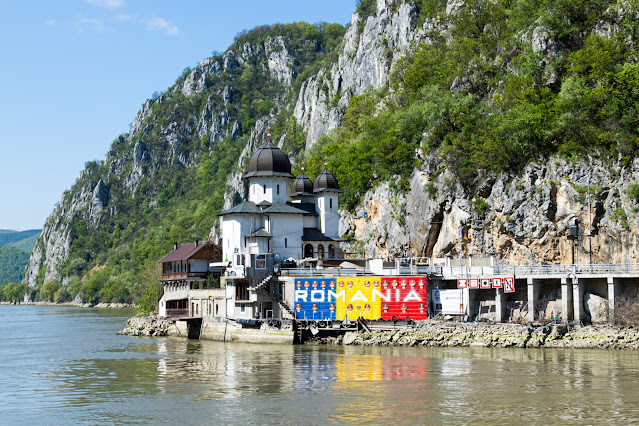 |
| Approaching the monastery. |
 |
| Close up of the coins. |
 |
| Rounding the bend after the monastery. |
Shortly after, we arrived in Donji Milanovac, gateway to Djerdap National Park and an 8,000 year old Mesolithic archaeological site. The national park is famous for its sweeping views of the Iron Gate gorge, within which lies Lepenski Vir (one of the most important archaeological sites in Serbia and the oldest planned settlement in Europe). When I got off the longship (my mom stayed onboard), my small hiking group walked to the national park's visitor center. The visitor center shows the variety of animals and plants and reminds me of the Natural History Museum in LA with its content. After a quick visit, we drove twenty minutes to the start of our hike. The Djerdap National Park is in the northeastern part of Serbia, on the border with Romania and has been under state protection since 1974. The park is home to lynx, wolves, jackals, bears, wild cats, otters, foxes, martens, and chamois and is an internationally important area for birds. Our hike turned out not to be much of a hike... The path that the leader chose was a quick hike down a hill with a very brief incline back up at the end of the hike for views of the gorge. Below are some photos.
 |
| The start of the trail. |
 |
| Going down! |
 |
| View from the top of the hill, facing the mountains. |
 |
| View from the top of the hill, facing the gorge. |
On the way back to the longship, we stopped at an artist studio where we had local Serbian treats.
 |
| The walkway to the main house. |
 |
| Serbian treats, including fried nettle which was actually really tasty! |
By the evening, we were on our way to Belgrade, the former capital of the state of Yugoslavia and today's Serbian capital. Belgrade is one of the oldest cities in Europe and its location at the confluence of the Sava and Danube Rivers and at the intersection of Eastern and Western Europe has long made it a contested region. Throughout its history, the "White City" (a reference to its massive fortress built on a white ridge above the confluence of the Danube and Sava) has been destroyed and rebuilt 20 times. Pope John VII first recorded the name "Belgrade" in 878 in a letter to the Bulgarian emperor but, over time, Belgrade has had well over a dozen names. Various prehistoric cultures existed here until tribes of Thracians and Dacians ruled it, followed by Scordisi Celts and Romans. Atila the Hun ransacked the city in 442 and with him came waves of barbarians-- the Slavs and the Turks. The Turks left Belgrade for good in 1867 and the city became the capital of a newly liberated Serbia.
Since I was in Belgrade in 2019 and my mom had never been, we opted for the included panoramic Belgrade tour. We drove around the new part of the city and the old part of the city, briefly stopping in the Church of Saint Sava. To this day, I think it's the prettiest church I've visited with its gold interior... and I'm not religious!
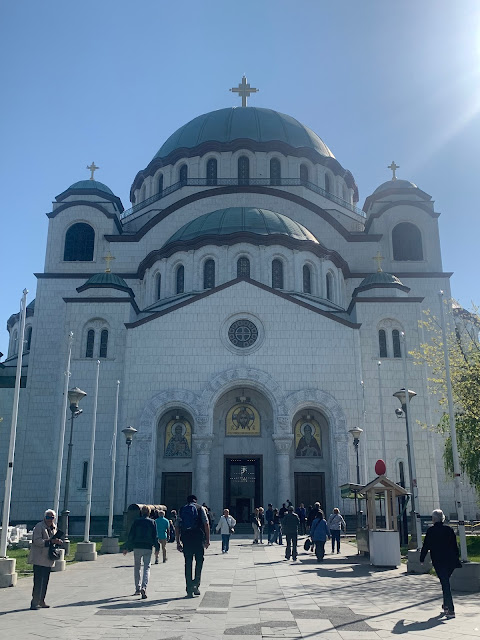 |
| The exterior of Saint Sava. |
Here are some interior pics...
 |
| Even the ceiling is gold! |
We ditched the group on the pedestrian street, opting to take the 100+ stairs down to the longship. I passed by the same mural I had taken a photo of in 2019 along the way!
Later in the evening, we had an authentic Japanese meal at Ebisu, where I had eaten in 2019. After raving about it to my mom, she was finally able to go! We feasted on crunchy shrimp tempura rolls, fresh salmon nigiri (my mom said it was the best salmon she's ever had... and she lived in Japan!), tuna nigiri, roasted miso eggplant, garlic noodles, and of course a Kirin beer. Food photos below, but don't look if you're hungry!
Stuffed, we walked back down the long flight of stairs to the ship. On the morning of April 22, we docked in Novi Sad, another city I visited in 2019 and one of the quaintest towns I've visited in Europe (it's also Serbia's second largest city).
 |
| Our pontoon in Novi Sad. |
The city has been called the "Serbian Athens" due to its history and art and was recently named a "European Capital of Culture" in 2021 and 2022. During our walking tour, we visited a farmer's market, tasted uštipci (fried dough balls), the main square and main walking street, and the Novi Sad Synagogue where we enjoyed a short concert performed by members of the Jewish community. The concert trio "Maya" performed Schindler's List, Shoshana, If I Were a Rich Man, Adio Kerida, and Hava Nagila.
 |
| The exterior of the Novi Sad Synagogue. |
Below are some pictures from Liberty Square, lined by sidewalk cafés and restaurants. Liberty Square, also known as Trg Slobode, is home to iconic landmarks including the impressive Name of Mary Church constructed in 1892 in the Gothic Revival style. Across the square from the church is the Muzej Vojvodine, a massive art and natural history museum.
The following two days, the longship docked in Illok, Croatia and Mohacs, Hungary. Unfortunately, we both caught a bit of a cold because everyone was coughing and sneezing on the tour buses, so we spent these days drinking lots of tea with honey, eating lots of double chocolate chip cookies, and planning our own sightseeing for our remaining few days in Europe (we quickly found out that the included shore excursions were often not what we wanted to see). Thankfully, by the time we arrived in Budapest on April 25, our cold was knocked out and we were ready to explore once more.
 |
| Sailing under Liberty Bridge. |
 |
| Our longship as seen from across the river. We had to walk across two others to disembark. |
Hungary's enchanting capital exists on both banks of the Danube, with traditional hillside Buda on one side and modern Pest on the other. I ended up arranging a private half day tour of Budapest, cramming in all the major sites. We started at Fisherman's Bastion before the crowds got there passing Buda Castle enroute.
The beauty of a private car and guide on this particular day was that we could drive to the top of Fisherman's Bastion, where the big tour buses can't go (we passed hoards of people on tours as we drove up). Halfway up, we made a quick photo stop.
With its elaborate neo-Gothic and neo-Romanesque profile, Fisherman's Bastion appears old but was built between 1895 and 1902 based on a design by the architect Frigyes Schulek.
After nearly being destroyed in World War II, its restoration was overseen by his son. Today, Fisherman's Bastion sits atop Castle Hill on the Buda side of the Danube and is a cluster of white stone towers, arches, terraces, and columns built upon the Buda Castle walls. The name Fisherman's Bastion derives from the guild of fishermen who were charged with defending this section of the castle walls during the Middle Ages. Here you can also find Matthias Church, named for the country's most popular medieval king.
From the seven turrets (representing the Magyar tribes that entered the Carpathian Basin in the late 9th century), you're treated to beautiful views of the Chain Bridge and the Hungarian Parliament building. Below are some photos around Fisherman's Bastion.
While here, we stopped into a Herend store. My mom's mother once bought Herend in Hungary and, as a tribute to her, my mom wanted to do the same. We left with a small turtle hatchling, which I picked out because it reminded me of our recent Sri Lanka experience releasing baby turtles into the ocean.
We proceeded to drive to Heroes' Square, the largest and most symbolic square in Budapest. It's dominated by the Millenary Monument, a pillar topped by a golden Archangel Gabriel holding the Hungarian crown and a cross.
At the column's base are Prince Árpád and six other Magyar chieftains who occupied the Carpathian Basin in the late 9th century.
The fourteen statues in the colonnades behind are rulers and statesmen.
We also visited the famous monument, Shoes on the Danube Bank, not far from the Hungarian Parliament building. Sixty pairs of iron shoes sit at the water's edge as a memorial to Hungarian Jews who, in the winter of 1944-1945, were shot on the banks of the Danube River by the members of the Arrow Cross Party. The memorial was installed in 2005 and conceptualized by the film director Can Togay and was created together with the sculptor Gyula Pauer.
Cast iron signs read in Hungarian, English, and Hebrew: "To the memory of victims shot into the Danube by Arrow Cross militiamen in 1944-45".
We continued our tour, driving on narrow streets with some of the most stunning architecture I've seen.
We briefly popped into the Hungarian State Opera's lobby, which was recently renovated (photos below), before saying goodbye to our private guide at Twentysix Budapest.
The founders of Twentysix call it an "urban jungle" and it's easy to see why. From the moment you step into the building, you feel like you're in one giant greenhouse in the middle of an urban city.
I had seen this restaurant on Instagram the day before we arrived in Budapest and made a reservation for lunch. We shared olives, an incredible labneh (with beetroot, zhoug, and Brazilian nut), falafels with tahini, garlic shrimp with cherry tomatoes, and a poppyseed cheesecake with plum jam, poppy seed tuille, and fresh kiwi. We each got a refreshing green tea mango lemonade too (the waiter accidentally brought us a grape elderflower lemonade, which we also tried. Of course, the green tea mango lemonade was the winner).
The following day, we had another jam packed day in Budapest. From our pontoon where we docked, we walked to the Central Market Hall. Unfortunately, we got there a bit too early and most vendors were closed, but it was still interesting to walk around it.
A short five minute walk away, we went to Matcha Tsuki for matcha lattes. I had found this matcha shop online, and we were pleasantly surprised to see them whisking matcha in the traditional way. The modern shop had Japanese decor and was the perfect place to get a caffeine fix for our long day ahead.
After an early lunch on board, we met our private guide for our street art tour. We ended up customizing the tour a bit, and took the tram from our pontoon to District VII in the Jewish Quarter. Together with our private guide, we walked around vibrant street art murals, popped into vintage shops, and walked past some of Budapest's synagogues including the famous Dohány Street Synagogue (Europe's largest).
We passed by the mural of "Sissy", Hungary's favorite queen. District VII is called the Jewish Quarter, but the official name for this area is Erzsébetváros (Elizabeth Town). The name comes from Hungary's favorite queen, the Hapsburg royal Empress Elisabeth (Sissy) who inspired the below mural. Sissy is the face of the neighborhood named after her, and the mural has a roll call of the most important street names in the district. Rumbach Sebestyén utca, the street this mural is on, is highlighted in yellow -- it's a love letter to the district.
Opposite it, we came across the Rubik's Cube mural. The mural of the Rubik's cube, which was invented in Budapest, celebrates the 40th anniversary of the invention of the Rubik's cube and the 70th birthday of its inventor, Erno Rubik. This mural is also an optical illusion because, while it looks like a Rubik's cube in photos, in person it's a bunch of dots and you can't make out the shape. This is because the camera picks up different colors than your naked eye. The visual puzzle echoes the inventor's motto: "There is always a solution – and not just one".
Below are some other murals and smaller street art drawings we passed along the way.
On our tour, we also visited the Szimpla Kert ruin bar (which literally translates to Simple Garden). Here it is from the outside.
It's the oldest ruin bar in Budapest with a vibrant atmosphere. During the day it's less crowded but by night, it's packed with tourists and locals alike. Every Sunday there is a farmer's and flea market with traditional and alternative foods, farmer's fresh produce, jams, honeys, fruits, veggies, etc. A ruin bar is exactly what it sounds like: a bar in the ruins of an old house. This one is largely open air with various rooms and funky decorations. It seems like something you'd see in Venice, CA, and it's amazing in every sense of the word. We stuck to lemonade while exploring the massive ruin bar! I could've stayed there all day photographing.
We returned to our ship in the late afternoon and enjoyed a scenic nighttime sailing out of Budapest towards Slovakia. From our balcony, we had stunning views of the Hungarian Parliament Building which lights up at night. The neo-Gothic Parliament dominates the Danube's left bank and was designed by architect Imre Steindl. Between 1885 and 1902, a thousand workers constructed the building. The exterior features 24 towers and 90 statues of Hungarian heroes. The corbels are ornamented with 242 allegorical statues and, inside, there are 691 rooms, 10 courtyards, and 29 staircases (much of it decorated with 88 pounds of gold).
In Bratislava, Slovakia, we arranged another private tour to pack as much sightseeing in as we could. Bratislava is the only national capital that borders two other countries (Austria and Hungary) and is a small city with restored baroque buildings. The Little Carpathians rise in the north, and the Old Town boasts elegant mansions, art nouveau houses and pedestrian zones. The area that comprises Slovakia was inhabited as early as 270,000 BC. By 500 BC, Celts had settled in Slovakia, followed by the Romans. Today's Slovaks are mainly descended from Slavic people who settled in the Danube River basin in the 6th and 7th century. Around 830 AD, they united to form Greater Monrovia, but the kingdom was short lived and was conquered by the Hungarian Magyars in the 10th century. In the 16th century, Slovakia became part of the Hapsburg Empire. Today, Slovakia is a modern country with a strong market economy with a social security system that offers universal health care, free education, and generous civil liberties.
We first drove to Devín Castle, surrounded by the Little Carpathians, Devínska Kobyla, the Danube River and the Morava River. The Devín area was of strategic importance due to the intersection of the amber road and the Danube road, both important early trade routes. The oldest findings here date to the Neolithic times. In the late Stone Age, the castle hill area was settled more intensively and in the early Bronze Age, the hill was home to a hillfort settlement with fortifications made of wood and earth. Over time, it was occupied by peoples of the Velatice culture, Podolí culture, the Kalenderberg culture, and even the Romans.
The stone castle of the Middle Ages was built in the second half of the 13th century. The section fortified was on a difficult to access cliff and the original tower had foundations in the shape of an oval teardrop. During this time, the castle became an important border castle protecting the Hungarian Kingdom's western border. In the early 15th century, it was taken over by the Garay noble family and in 1460 it was acquired by the Lords of St George and Bösing. In 1521, however, they were forced to return it to King Louis II of Hungary. Fast forward to several anti-Habsburg uprisings, the last noble family to control the castle (the Pálffys) sold the castle to the Szechoslovak Republic. In 1809, troops of Napoleon's army placed explosives under the castle during the siege of Bratislava and blew it up (the reason for the demolition remains a mystery). Below are some photos of the castle.
In 1961, Devín Castle was declared a National Cultural Monument and it is also an area of geological significance with an underground museum at the top of the castle. To get to the museum, you need to climb down a steep metal ladder, pictured below. Once you are under the castle, there are glass cases with cannonballs, keys, family crests, and more.
After exploring the castle, we hiked back down the hill to the parking lot where we popped into a shop for a delicious strudel.
We continued on a brief walking tour of Old Town (pictures below) before heading back to the ship.
Back at the ship, we snacked on a pretzel we bought at one of the famous shops.
As we sailed towards Vienna, our last stop on the trip, we passed by Bratislava Castle. A blazing white square cornered by four red-roofed towers, this castle dates to the Middle Ages but was rebuilt and burned several times in its 1,000+ year history and was also reduced to just its shell during the Napoleonic wars. Serious renovations began in the 1960s and an even larger rebuilding started in 2008.
Further down the river, we passed Devín Castle. As I was photographing outside (during dinner!) other guests were speculating what it was. I told them I was there earlier, and it's safe to say they were very jealous, ha!
On our last day of the trip, we had a leisurely morning before going out in the early afternoon for a museum day. We first went to the Kunsthistorisches Museum, recommended by my boyfriend's friend and it was easily the best museum we've ever been to anywhere in the world. Here are some exterior/interior architecture pictures. The museum is impressive just from its architecture alone!
We could've spent days in the museum, but we tackled the highlights in a few hours. We started with their special exhibit, Around the World in 80 coins, which had thousands of coins dating from 375 BC to 1944 and featured coins from all corners of the globe.
You could have spent days in that exhibit alone, with all the intricate details of the coins and the stories of how they were traded. We then went downstairs for a coffee and apple strudel break... the best apple strudel of the entire trip.
We then visited the jaw-dropping Picture Gallery, which houses many famous works including the Tower of Babel which I had studied in my numerous college art history classes. It was amazing to see it in person, and the scale of the paintings in the Picture Gallery was unlike anything I had seen before.
We also spent time in the Egyptian and Near Eastern Collection and the neighboring Greek and Roman Antiquities gallery. Of all the exhibits we saw, the Egyptian exhibit blew our minds. From the moment you walk in, you feel like you're in an Egyptian tomb with richly painted ceilings, temple columns, and hundreds of artifacts unobstructed by glass (would that ever happen in the US? I don't think so). The collection houses more than 17,000 objects from a period of almost four thousand years and the collection is organized into four areas: funerary cult, cultural history, sculpture and relief, and the development of writing. The sarcophagi and coffins alone are incredible and there's even part of an Egyptian pyramid you can walk into. Below are some highlights from the Egypt exhibit...
...And a few from the Roman/Greek exhibit...
After a visit to the gift shop, we walked approximately twenty minutes to the nearby Albertina Modern where we had tickets to see the Andy Warhol and Damien Hurst: Revolution in Printmaking exhibit. The collection of approximately 70 printed graphics reflects post-1945 phenomena and features works by Andy Warhol, Robert Rauschenberg, Roy Lichtenstein, Agnes Martin, and more. The museum is impressive, and is among the world's largest museums of modern and contemporary art with its over 60,000 works by 5,000 artists. It doesn't look large from the outside, but the inside goes on and on! Below are some photographs of the exhibit.
By the time we finished up at the Albertina Modern, we had a little time to kill before our dinner reservation at 5 PM. We ducked into a sports bar for a snack (and though they were known for their Philly cheesesteaks, we opted to share a wrap). Shortly after, we took an Uber to a Japanese restaurant where we had a light dinner at DiningRuhm. Housed in Vienna's fourth district, the restaurant is a fusion cuisine characterized by Peruvian Nikkei influences. While they're known for their set menus, we were not very hungry so we opted for the à la carte menu. We ordered mini yellowtail tacos, mini tuna tacos, salmon nigiri, eel nigiri, soft shell crab futumaki, and a lobster roll. Below are some pics!
The next morning, we bid farewell to our longship and headed to the airport for the long journey home. Unlike our flight from the US to Europe at the start of the trip, the flights home went off without a hitch.
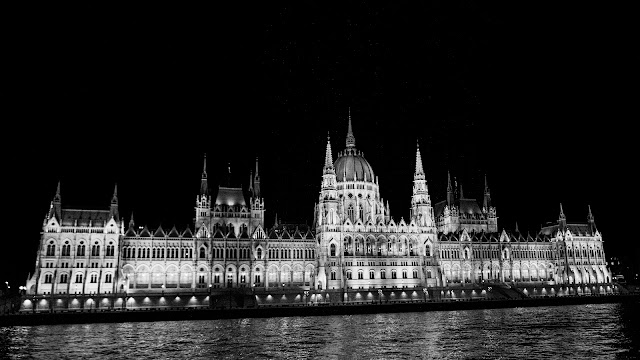

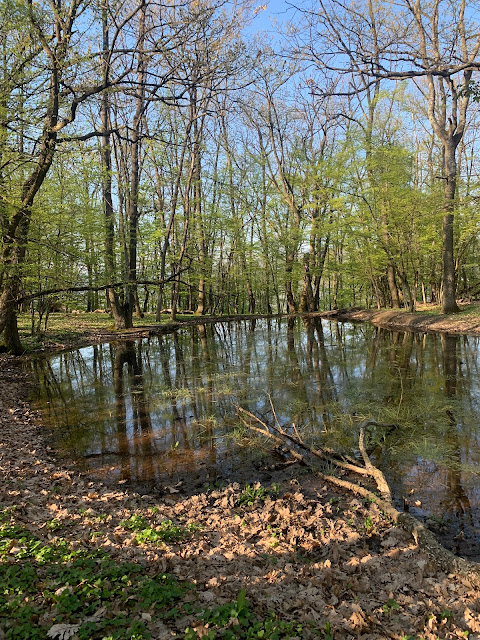






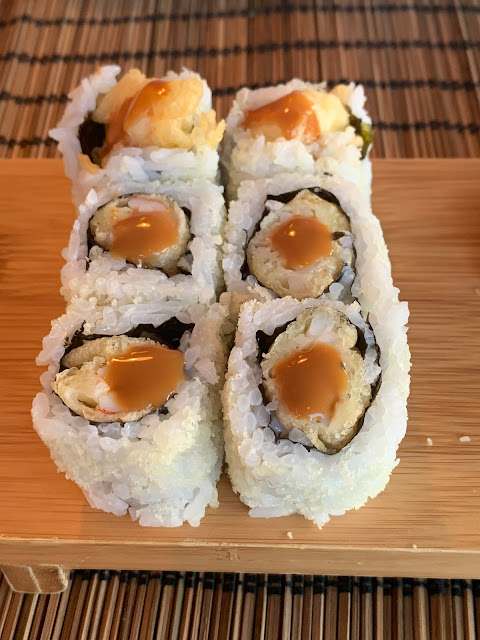


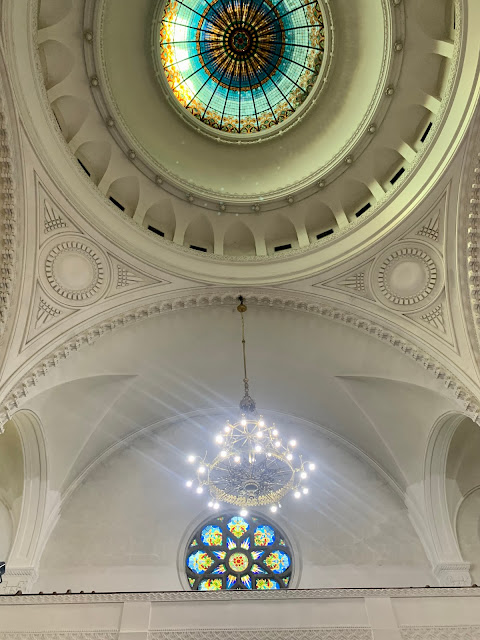










































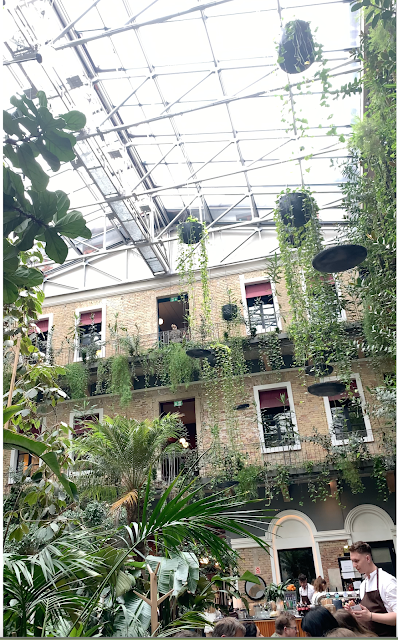


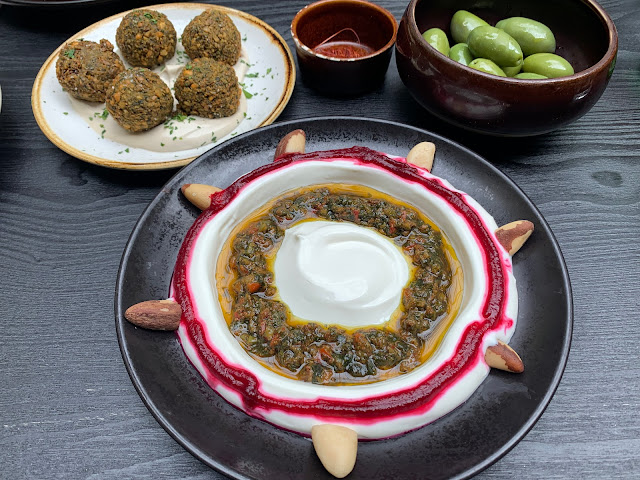




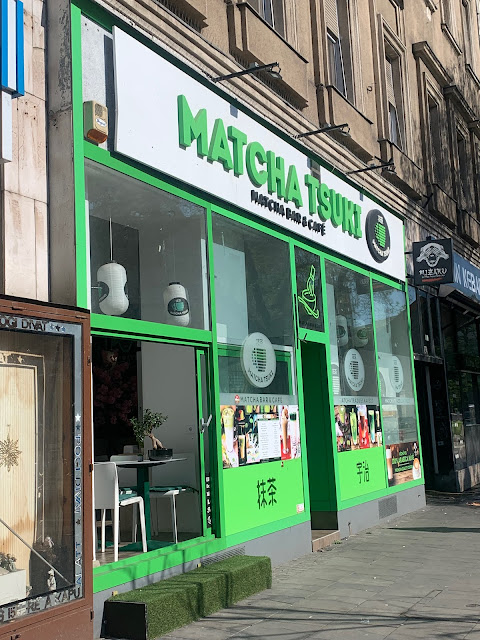













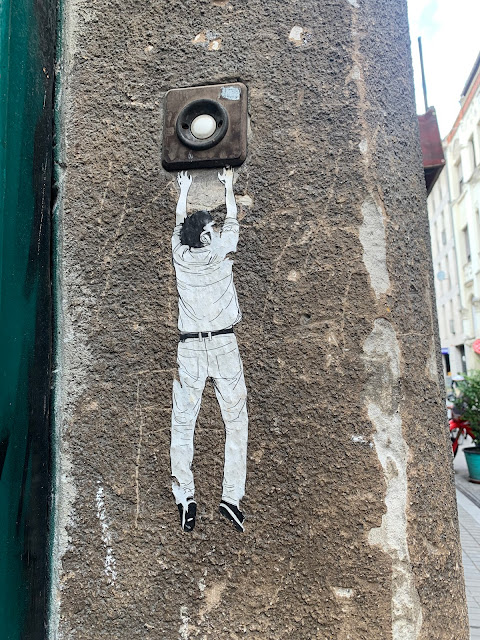





























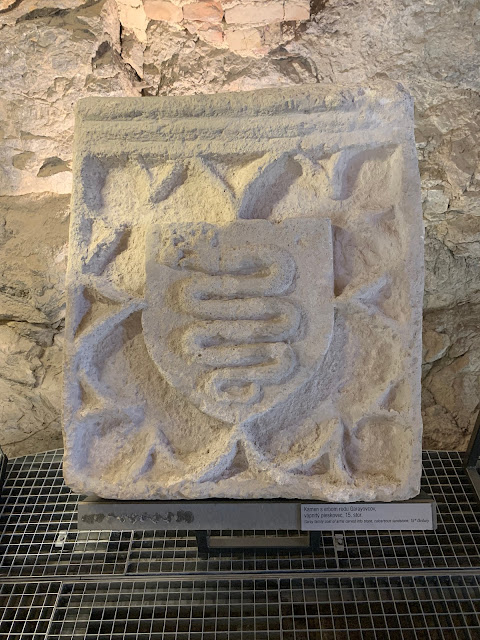
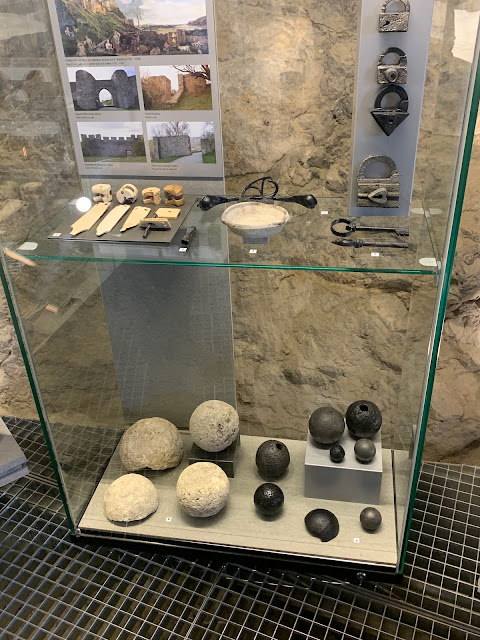
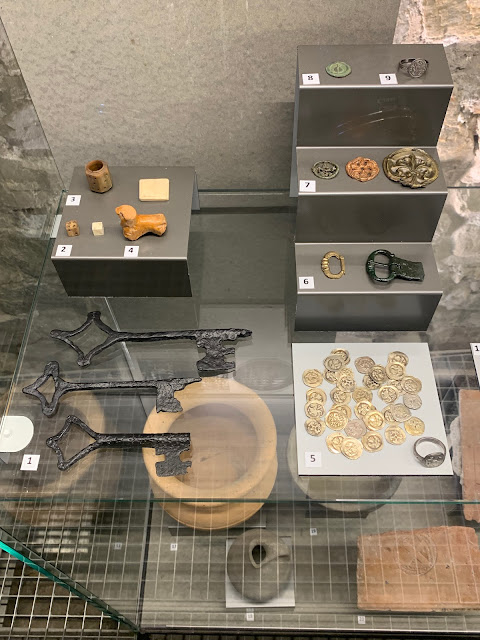








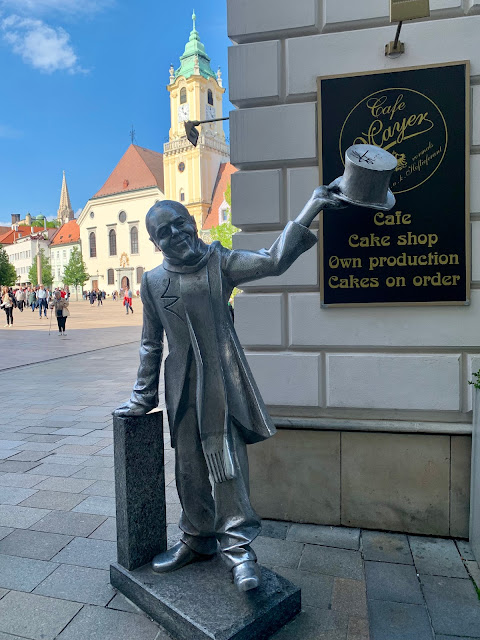

















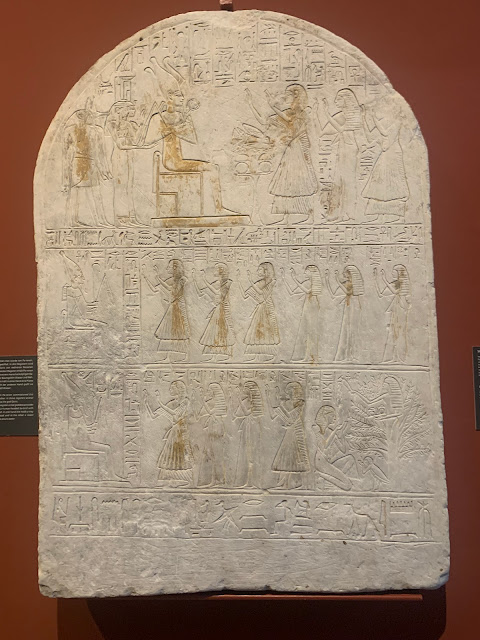













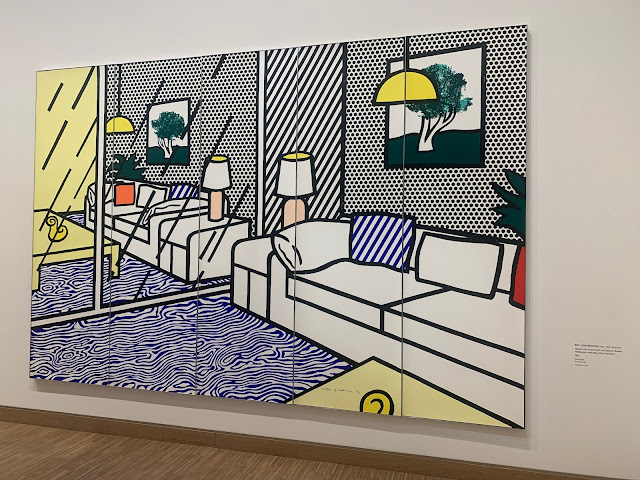









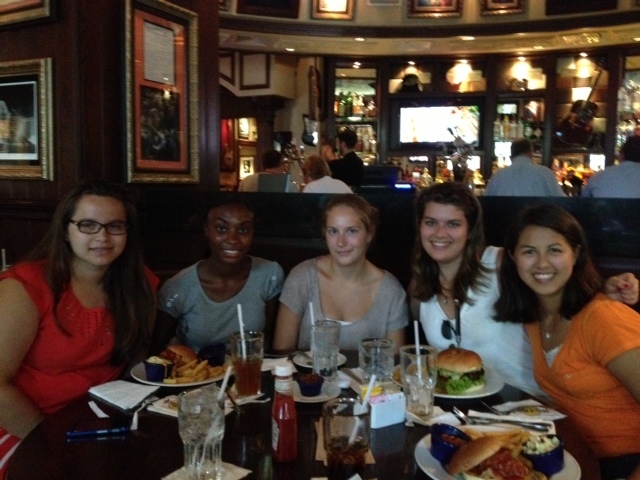
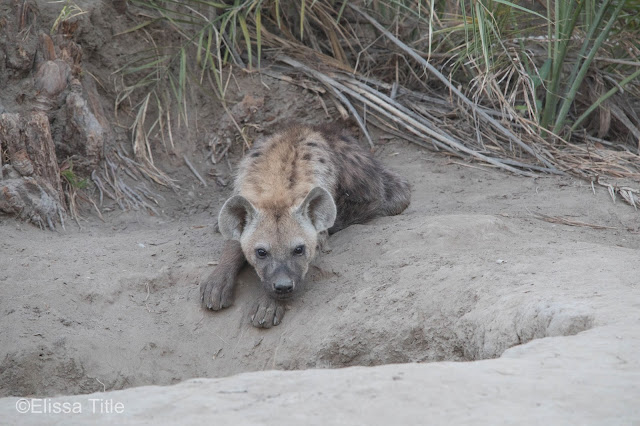
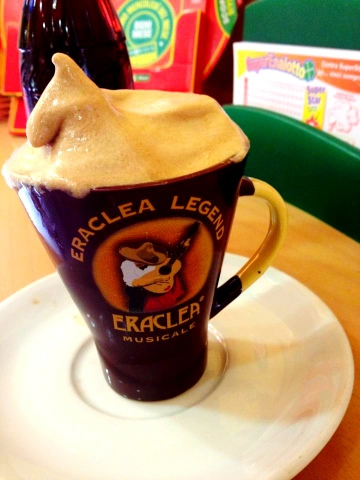



Comments
Post a Comment